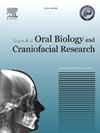Antibiofilm efficiency of silver and copper nanoparticle incorporated calcium hydroxide as an intracanal medicament: An in vitro study
Q1 Medicine
Journal of oral biology and craniofacial research
Pub Date : 2025-02-11
DOI:10.1016/j.jobcr.2025.01.020
引用次数: 0
Abstract
Background and objectives
Silver (Ag) and Copper (Cu) Nanoparticles (NP) are a potential substitute for disinfection during endodontic therapy because of their antibacterial action against an array of pathogens, including resistant strains. This study aimed to assess the antibiofilm efficiency of calcium hydroxide modified with Ag and Cu NP suspension against E. faecalis, using confocal laser scanning microscopy (CLSM) and colony forming units (CFU) analysis.
Methods
Dentine blocks were inoculated with Enterococcus faecalis for one week and 1 week-old biofilm of E. feacalis were randomly divided into 4 groups, control, calcium hydroxide, calcium hydroxide +2 % Cu NP and calcium hydroxide +2 % Ag NP. Following the incubation of the specimens with the medicament for 24 h at 37C, CLSM was used to evaluate the reduction in biovolume of the biofilm and the CFU was determined to assess the antimicrobial action of the NP-modified calcium hydroxide.
Results
CLSM images revealed a significant reduction in the thickness of biofilm in both Ag and Cu groups compared to calcium hydroxide alone. The CFU results showed that group 4 and group 3 showed significantly less CFU followed by group 2 and group 1 (p < 0.001).
Conclusion
Adding Cu and Ag NP to calcium hydroxide intracanal medication significantly increases its antibacterial activity against E. faecalis.

银和铜纳米颗粒加入氢氧化钙作为内源性药物的抗生物膜效率:体外研究
背景与目的银(Ag)和铜(Cu)纳米颗粒(NP)具有抗菌作用,可对抗包括耐药菌株在内的一系列病原体,是牙髓治疗过程中消毒的潜在替代品。本研究旨在通过共聚焦激光扫描显微镜(CLSM)和菌落形成单位(CFU)分析,评估银铜NP悬浮液修饰的氢氧化钙对粪大肠杆菌的抗菌膜效果。方法用粪肠球菌接种1周后,将1周龄的粪肠球菌生物膜随机分为对照组、氢氧化钙组、氢氧化钙+ 2%铜NP组和氢氧化钙+ 2%银NP组。37℃孵育24 h后,用CLSM评价生物膜的生物体积减少情况,用CFU评价np修饰的氢氧化钙的抑菌作用。结果clsm图像显示,与氢氧化钙单独相比,Ag和Cu组的生物膜厚度明显减少。CFU结果显示,第4组和第3组的CFU显著低于第2组和第1组(p <;0.001)。结论在氢氧化钙中加入铜和银NP可显著提高其对粪肠球菌的抗菌活性。
本文章由计算机程序翻译,如有差异,请以英文原文为准。
求助全文
约1分钟内获得全文
求助全文
来源期刊

Journal of oral biology and craniofacial research
Medicine-Otorhinolaryngology
CiteScore
4.90
自引率
0.00%
发文量
133
审稿时长
167 days
期刊介绍:
Journal of Oral Biology and Craniofacial Research (JOBCR)is the official journal of the Craniofacial Research Foundation (CRF). The journal aims to provide a common platform for both clinical and translational research and to promote interdisciplinary sciences in craniofacial region. JOBCR publishes content that includes diseases, injuries and defects in the head, neck, face, jaws and the hard and soft tissues of the mouth and jaws and face region; diagnosis and medical management of diseases specific to the orofacial tissues and of oral manifestations of systemic diseases; studies on identifying populations at risk of oral disease or in need of specific care, and comparing regional, environmental, social, and access similarities and differences in dental care between populations; diseases of the mouth and related structures like salivary glands, temporomandibular joints, facial muscles and perioral skin; biomedical engineering, tissue engineering and stem cells. The journal publishes reviews, commentaries, peer-reviewed original research articles, short communication, and case reports.
 求助内容:
求助内容: 应助结果提醒方式:
应助结果提醒方式:


